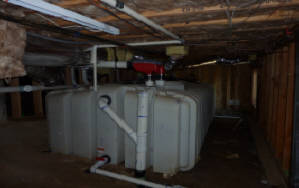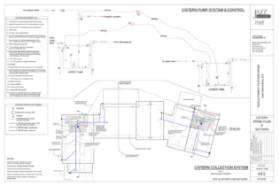



















water harvesting
At Jazz Builders, we believe it is our responsibility to design and implement systems that will have less of an impact on our planet's precious resources. Although the earth is nearly 75% water, most of it is contained in our vast oceans and is neither potable or is it easily desalinated or transported for domestic purposes. By harvesting the rain that falls on the roofs of our homes we can, as individual property owners reduce our need to purchase water from our local municipality. Rainwater collection and storage is a common practice in many arid locations around the globe, but is fairly uncommon in most parts of the U.S.
The practical application of rainwater collection is simple and straightforward. The roofs of most homes are large enough to effectively capture the rainwater via the gutters commonly attached to the roof's edge. From the gutter, which needs to be properly screened to reduce the infiltration of leaves and other debris, the water is transported to holding tanks via the building's downspouts and piping. Prior to entering the storage tanks (cisterns), the water is filtered again to further reduce the amount of vegetative debris, bird droppings, etc. The rain water then enters the tank through a "calming" inlet which reduces the turbidity of the water in the tank and refrains from stirring up the water at the bottom of the tank. The water is then available for use as irrigation water during the dry months. There are a couple of ways of providing the stored water to the landscape irrigation system. One simple way is through gravity, but this requires that the home and storage

tanks are above the landscaped area requiring water.
Another way is through submersible pumps which sit on the floor of the cisterns and pump water into the irrigation system upon demand.
We are in the final stages of completion for a new custom home in San Geronimo, CA. Our design uses float switches as controls and a 3-way electromechanical valve to switch between municipal water and harvested rainwater. This allows for the irrigation system to use all of the available water in the cisterns prior to switching to municipal water. In this system, the cisterns are located under the building in a large "crawl" space as the building is built on a steep hill which provided large spaces under the building. There are two tanks, one at either end of the building, each collecting water from different areas of the roof. One tank is at a lower elevation and is designated as the secondary tank, filling the primary tank upon demand. The water from the secondary tank is pumped to the primary tank using a submersible pump and a pump controller. The primary tank provides pressurized water to the irrigation system upon the opening of irrigation valves.
We at Jazz Builders, believe that through the implementation of reasonably simple systems like the one described above, property owner's can be more self sufficient and reduce the pressure for our municipalities to supply water for non domestic purposes, and save money on their monthly water bill at the same time!


